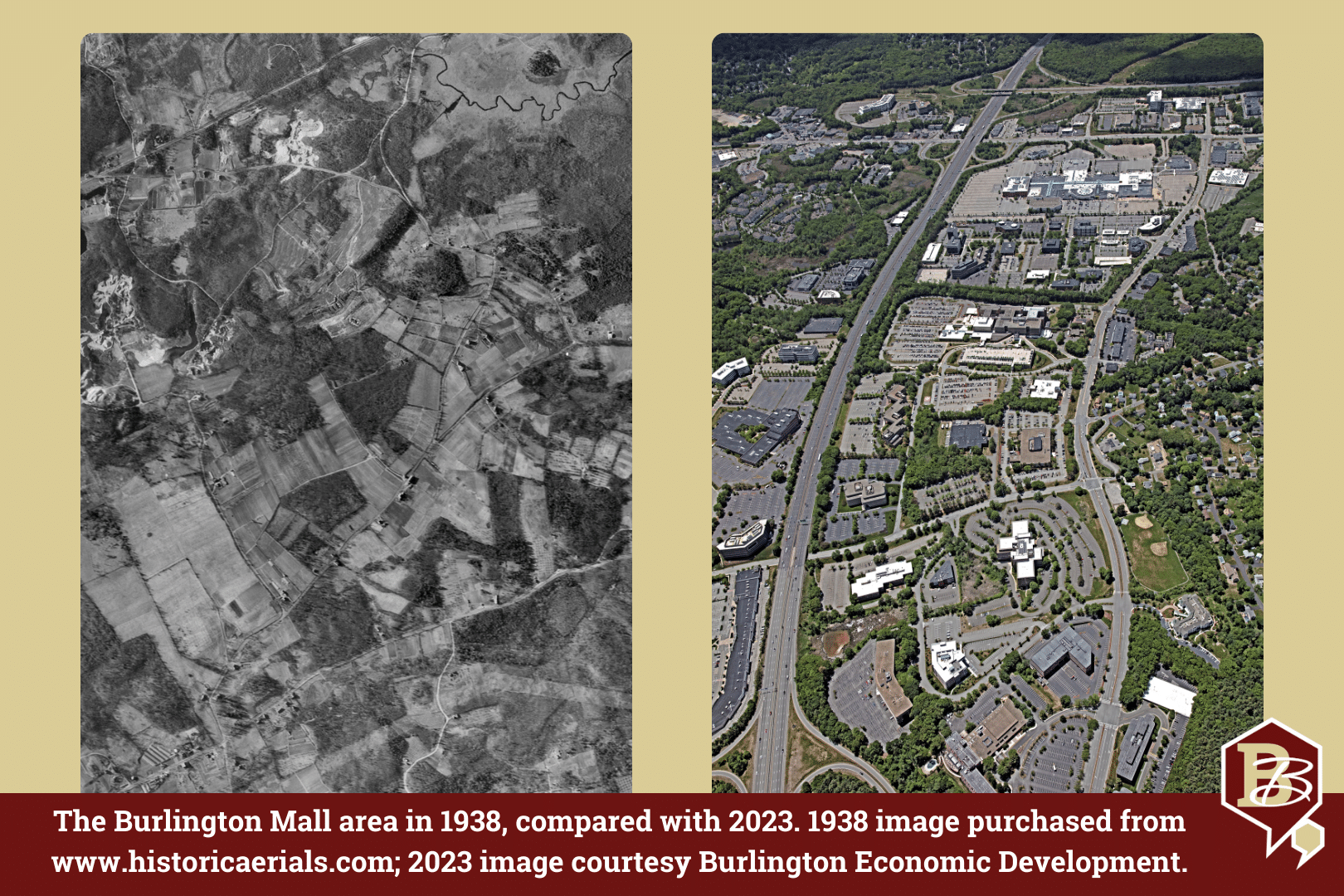Buzz In-Depth | Burlington Mall Road Corridor
A major seat of business in Burlington

It’s hard to imagine as you drive through Burlington that the town used to have more livestock than humans. In fact, when it was incorporated in 1799, the major industry was agriculture with a focus on pig farming. Good luck finding someone in town whose property didn’t used to be a pig farm.
Things changed in the 1950s, when the 128 freeway was built to ease traffic in cities and towns and make travel more convenient for drivers. Suddenly, office parks began popping up along the freeway, populated by technology and telecommunications companies working on innovations in the field. The town of Burlington recognized the value of this commercial development and to this day encourages the most innovative of companies to conduct their business in Burlington.
The Mall itself—sadly, the only thing many New Englanders know Burlington for—was built in the mid-60s, around the same time as New England Executive Park. The idea was to expand retail options and leverage the population growth and commercial growth to create a center of commerce in a place where people had already begun coming to live and do business.
The area was zoned 60 years ago, with the vision of engineers and planners from the 1960s—an era before personal computers and cell phones, when public transportation in the suburbs was a fantasy. As you can imagine, things have changed since then, and that change was impacted and accelerated by the pandemic.
Rethinking the Mall Road Area
Much discussion has been had in the last several years about modernizing and revitalizing the Mall Road Corridor. The mall itself has undergone a considerable makeover over the last ten or so years, adding outdoor and more interactive features and experience-oriented stores like CAMP in the place of pure retail options. But the area around the mall is no longer functioning as well as it could for the town’s needs in this modern age.
The question the town has been charged to answer: How can this area be transformed into a place where people can live, work, and play—an area with more open space, more areas for structured recreation, and more of the kinds of businesses residents and visitors will be looking for in the mid-21st century?
The Economic Development Department, along with MassDevelopment, has been working to study the area and, with the support of Town Meeting, created a proposal for new zoning in the Mall Road Corridor that would include design standards that builders must follow. Basically, this is a way to create mixed-use spaces with a cohesive look and feel throughout the area and develop the property in a way that will meet the needs of Burlington 30-50 years from now.
In the 500-acre initial study area, the team found 100 acres of underutilized surface parking lots. In addition to being unsightly and unnecessary, these lots can impact our local climate via heat island effects, raising the temperature more than would naturally occur. Redeveloping these lots can help keep property values up, says Economic Development Director, Melisa Tintocalis, while offering opportunities to consolidate parking, provide open space, and create a mix of uses like housing, recreation, and small retail in a single space.
Funding and Priorities
This project has been ongoing and involved a series of three community forums as well as work with a consultant to create a (very long) document that outlines the proposed zoning. In addition to securing $80,000 from Town Meeting in September of 2022, the Economic Development department has received two grants to help fund this project.
The main priority when creating this draft plan was alignment and cohesion with the town’s Master Plan. Referencing such plans when imagining the future of the town is essential to ensure the work done in this area will support the vision, intention, and recommendations set forth and endorsed by the town at large. The Master Plan’s recommendations regarding land use, open space, economic development, and housing have been incorporated into the zoning.
The other priority is to enhance the area and make it work for today’s world (and the world of the future). Hybrid and remote work has decreased the need for parking, and large, flat parking lots can be consolidated into multi-level structures to leave space for other uses of that land.
“We have to pay attention to the public realm,” says Tintocalis. The town can no longer build for people to just come to work, stay there for eight hours, and go home. Many people don’t want (or have the time or ability) to drive everywhere during their work day, and many enjoy the convenience of nearby dining for lunch or post-work gatherings. People crave open space and the ability to walk easily to the places they need to access during the day, which means the area needs to be walkable and the places need to be reasonably close together.
The Mall Road area consists of about 8-9% of the town’s land but it represents a high commercial value, as well as a large number of potential jobs that could come to the area. The town has involved community members in imagining what the area could look like and is invested in the zoning being truly community-driven. “The question we keep asking ourselves,” says Tintocalis, “is, ‘What does Burlington want?’” Every step in the process has been designed to answer these questions and incorporate those answers into the future plans.
And one certainty is that there will be development pressure in the town’s future. Zoning is a tool the town can use, says Tintocalis, to shape the characteristics of that development. Data has shown the value in this kind of coherent design, provided developers are invested in helping the town meet its vision for looking and functioning better in the longer term. This work will enhance the benefit this new development brings to the community, adding the two most referenced needs/desires expressed by residents and town representatives: housing and open space.
And the best part? Zoning doesn’t require any financial investment on the part of the town, aside from the work already done to create the plan.
How Can This New Zoning With Design Standards Help Burlington Meet Its Other Goals?
This initiative would create a mixed-use zone with a cohesive look in arguably the most heavily-frequented part of town. That’s a noble goal in itself, but the project as the added ability of helping Burlington with one of the biggest and persistent problems it’s faced over the last several years: housing.
The Housing Needs Assessment, completed two years ago and presented in early 2022, showed the need for more middle housing and more diverse housing types. In addition, the MBTA Communities law, enacted in 2021, requires Massachusetts communities to have a certain amount of multifamily zoning in order to be eligible for many state grants, which Burlington has benefitted from to the tune of $9,000,000 in the last ten years.
This rezoning could be an opportunity to meet both of these needs at once, as the goals of both initiatives are in alignment. Using the new zoning, the town could create multifamily zoning and later build housing in this mixed-use area that is close to the bus line and can be utilized by those who aren’t buying single-family homes but want to live in Burlington. This includes young families, those without children, seniors looking to downsize, and more. There is still work to do to figure out exactly how these programs might complement each other, but one thing is for certain: Currently there is no housing in the 500-acre study area. Adding some higher density housing in an area that has historically been zoned to not allow housing would increase the options available and ease the pressure any potential homebuyer has experienced.
The first meeting of the MBTA Communities Working Group was held on January 31, and the next will be held on February 12 from 5:30-7:30. These meetings are public, and are a great place to learn more about this initiative and how the town can comply. Join the February 12 meeting online, and learn more on the Town website.
The final draft of the zoning plan is complete, and the Economic Development Office is working to get a public-facing summary together to inform residents and allow for feedback.





